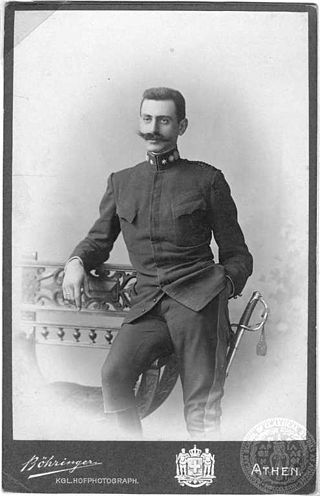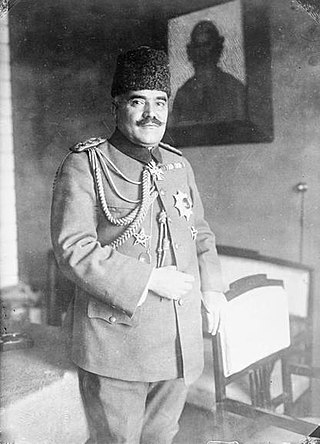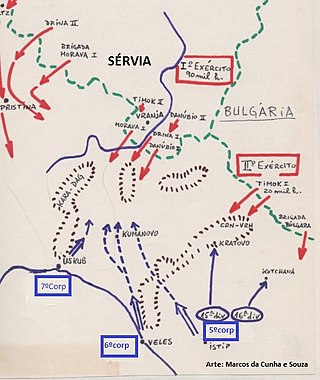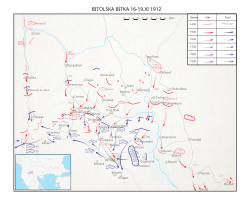
Bitola is a city in the southwestern part of North Macedonia. It is located in the southern part of the Pelagonia valley, surrounded by the Baba, Nidže, and Kajmakčalan mountain ranges, 14 kilometres north of the Medžitlija-Níki border crossing with Greece. The city stands at an important junction connecting the south of the Adriatic Sea region with the Aegean Sea and Central Europe, and it is an administrative, cultural, industrial, commercial, and educational centre. It has been known since the Ottoman period as the "City of Consuls", since many European countries had consulates in Bitola.

The Balkan Wars were a series of two conflicts that took place in the Balkan states in 1912 and 1913. In the First Balkan War, the four Balkan states of Greece, Serbia, Montenegro and Bulgaria declared war upon the Ottoman Empire and defeated it, in the process stripping the Ottomans of their European provinces, leaving only Eastern Thrace under the Ottoman Empire's control. In the Second Balkan War, Bulgaria fought against the other four original combatants of the first war. It also faced an attack from Romania from the north. The Ottoman Empire lost the bulk of its territory in Europe. Although not involved as a combatant, Austria-Hungary became relatively weaker as a much enlarged Serbia pushed for union of the South Slavic peoples. The war set the stage for the July crisis of 1914 and thus served as a prelude to the First World War.

The First Balkan War lasted from October 1912 to May 1913 and involved actions of the Balkan League against the Ottoman Empire. The Balkan states' combined armies overcame the initially numerically inferior and strategically disadvantaged Ottoman armies, achieving rapid success.

The Second Balkan War was a conflict that broke out when Bulgaria, dissatisfied with its share of the spoils of the First Balkan War, attacked its former allies, Serbia and Greece, on 16 (O.S.) / 29 (N.S.) June 1913. Serbian and Greek armies repulsed the Bulgarian offensive and counterattacked, entering Bulgaria. With Bulgaria's also having previously engaged in territorial disputes with Romania and the bulk of Bulgarian forces engaged in the south, the prospect of an easy victory incited Romanian intervention against Bulgaria. The Ottoman Empire also took advantage of the situation to regain some lost territories from the previous war. When Romanian troops approached the capital Sofia, Bulgaria asked for an armistice, resulting in the Treaty of Bucharest, in which Bulgaria had to cede portions of its First Balkan War gains to Serbia, Greece and Romania. In the Treaty of Constantinople, it lost Adrianople to the Ottomans.

Pavlos Melas was a Greek revolutionary and artillery officer of the Hellenic Army. He participated in the Greco-Turkish War of 1897 and was amongst the first Greek officers to join the Macedonian Struggle.

The siege of Adrianople, was fought during the First Balkan War. The siege began on 3 November 1912 and ended on 26 March 1913 with the capture of Edirne (Adrianople) by the Bulgarian 2nd Army and the Serbian 2nd Army.
The Bulgarian First Army was a Bulgarian field army during the Balkan Wars, World War I and World War II.

The Battle of Prilep in the First Balkan War took place on 3-5 November 1912 when the Serbian army encountered Ottoman troops near the town of Prilep, in today's North Macedonia. The clash lasted for three days. Eventually the Ottoman army was overwhelmed and forced to retreat.

The Battle of Sorovich took place between 21–24 October 1912 (O.S.). It was fought between Greek and Ottoman forces during the First Balkan War, and revolved around the Sorovich (Amyntaio) area. The 5th Greek Division which had been advancing through western Macedonia separately from the bulk of the Greek Army of Thessaly, was attacked outside the village of Lofoi and fell back to Sorovich. It found itself to be heavily outnumbered by an opposing Ottoman force.

The Battle of Bizani took place in Epirus on 4–6 March [O.S. 19–21 February] 1913. The battle was fought between Greek and Ottoman forces during the last stages of the First Balkan War, and revolved around the forts of Bizani, which covered the approaches to Ioannina, the largest city in the region.

The Battle of Kilkis–Lachanas took place between Greece and Bulgaria during the Second Balkan War. The two countries fought for the town of Kilkis in Central Macedonia from 19 to 21 June 1913 O.S. with Greece ultimately being victorious.

The history of the Jews in North Macedonia stretches back two thousand years, beginning during Roman antiquity, when Jews first arrived in the region. Today, following the Holocaust and emigration, especially to Israel, around 200 Jews remain in North Macedonia, mostly in the capital, Skopje and a few in Štip and Bitola.

The Battle of Dobro Pole, also known as the Breakthrough at Dobro Pole, was a World War I battle fought between 15 and 18 September 1918. The battle was fought in the initial stage of the Vardar Offensive, in the Balkans Theatre. On 15 September, a combined force of Serbian, French and Greek troops attacked the Bulgarian-held trenches in Dobro Pole, at the time part of the Kingdom of Serbia. The offensive and the preceding artillery preparation had devastating effects on Bulgarian morale, eventually leading to mass desertions.

Zeki Pasha, known as Mehmet Zeki Baraz Kolaç Kılıçoğlu after the 1934 Surname Law, was an Ottoman Balkan Wars and World War I field marshal of the Ottoman Army. He was of Circassian descent.

The Battle of Kumanovo, on 23–24 October 1912, was a major battle of the First Balkan War. It was an important Serbian victory over the Ottoman army in the Kosovo Vilayet, shortly after the outbreak of the war. After this defeat, the Ottoman army abandoned the major part of the region, suffering heavy losses in manpower and in war materiel.

The Monastir offensive was an Allied military operation against the forces of the Central Powers during World War I, intended to break the deadlock on the Macedonian front by forcing the capitulation of Bulgaria and relieving the pressure on Romania. The offensive took the shape of a large battle and lasted for three months and ended with the capture of the town of Monastir. On an average depth of 50km, the Bulgarian First Army gave battle on six occasions, being forced to retreat five times.
North Macedonia was part of the Ottoman Empire for over 500 years, from the late 14th century until the Treaty of Bucharest in 1913. Before its conquest, this area was divided between various Serbian feudal principalities. Later, it became part of the Ottoman province or Eyalet of Rumelia. The name Rumelia means "Land of the Romans" in Turkish, referring to the lands conquered by the Ottoman Turks from the Byzantine Empire.

The Vardar offensive was a World War I military operation, fought between 15 and 29 September 1918. The operation took place during the final stage of the Balkans Campaign. On September 15, a combined force of Serbian, French and Greek troops attacked the Bulgarian-held trenches in Dobro Pole, at the time part of Serbia. The assault and the preceding artillery preparation had devastating effects on Bulgarian morale, eventually leading to mass desertions.

The Kingdom of Serbia was one of the major parties in the Balkan Wars, gaining land in both conflicts. It experienced significant territorial gains in the Central Balkans, nearly doubling its territory.

Bitola railway station is the railway station of Bitola in Pelagonia, North Macedonia.



















